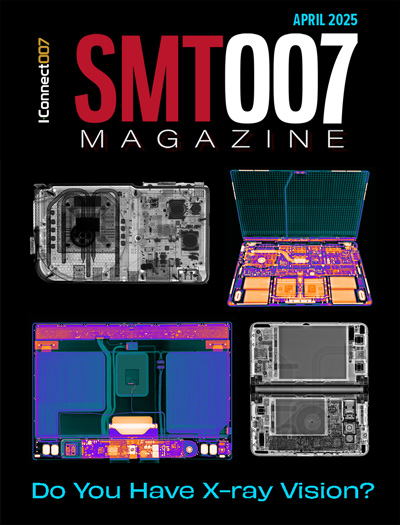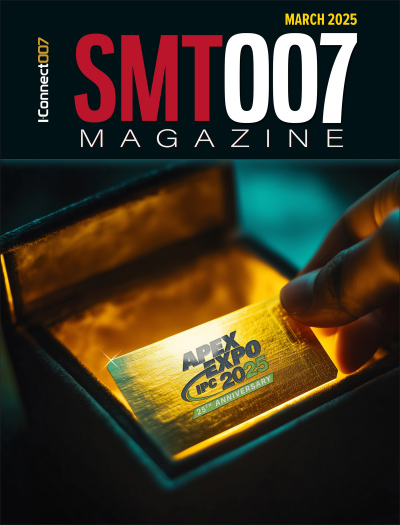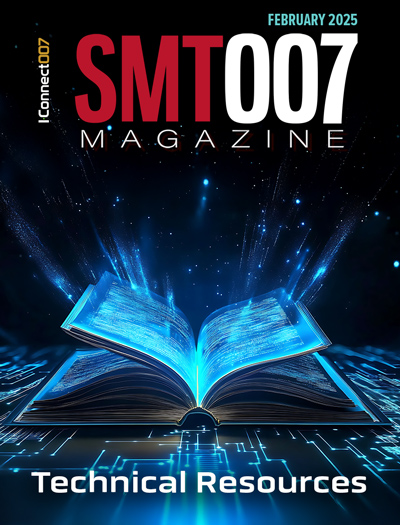-

- News
- Books
Featured Books
- smt007 Magazine
Latest Issues
Current Issue
Do You Have X-ray Vision?
Has X-ray’s time finally come in electronics manufacturing? Join us in this issue of SMT007 Magazine, where we answer this question and others to bring more efficiency to your bottom line.

IPC APEX EXPO 2025: A Preview
It’s that time again. If you’re going to Anaheim for IPC APEX EXPO 2025, we’ll see you there. In the meantime, consider this issue of SMT007 Magazine to be your golden ticket to planning the show.

Technical Resources
Key industry organizations–all with knowledge sharing as a part of their mission–share their technical repositories in this issue of SMT007 Magazine. Where can you find information critical to your work? Odds are, right here.
- Articles
- Columns
Search Console
- Links
- Media kit
||| MENU - smt007 Magazine
Making PCB Cleaning More Energy Efficient
December 31, 1969 |Estimated reading time: 9 minutes
New innovations in batch and in-line systems, combined with more effective chemistries, have made cleaning printed circuit boards (PCBs), stencils, and bare boards more cost-effective, environmentally friendly, and energy efficient.
BY Pete Singer, SMT
Most of the challenges in cleaning printed circuit boards (PCBs) are well known. Solder flux residue and contaminants must be completely removed from densely populated circuit boards, including beneath components that are close to the board (i.e., low standoff). Cleaning equipment, chemicals, and processes have evolved over the years to accomplish this quite satisfactorily. There are even no-clean solders and fluxes that are designed to eliminate the need for cleaning (although many people still clean them anyway, according to our reader survey, the results of which are presented throughout this article).
What's new is the push to ever greener, more energy-efficient methods to PCB cleaning/defluxing. Equipment is smaller and less power-hungry; cleaning chemistries are more environmentally friendly; recycling of water and chemicals has become the norm. Of course, the best energy savings is found when the clean is completed in one step. The perfect clean? "No white residue, no residues in tight gaps or blind holes, with lead-free and organic acid (OA) residues removed along with good material compatibility," according to Tom Forsythe, VP, Kyzen.
Batch vs In-line
When it comes to cleaning/defluxing equipment design, there are two fundamental machine formats: batch and in-line. Suppliers of each type claim that their approach is best when it comes to energy efficiency, and there has clearly been progress on both sides. Michael Konrad, president of Aqueous Technologies, said that there have been significant changes in the design of batch machines, to the point where it a "complete evolution." He said that in the past, batch cleaning systems were "little more than dishwashers," lacking in both cleaning power and throughput. "While there are still examples of that, many batch-format cleaners have been transformed into high-power, high-throughput defluxing machines. Modern batch-format cleaning systems provide an environmental advantage to in-line counterparts," he said.
Konrad said that best-in-class batch cleaning systems feature built-in, real-time cleanliness testing capabilities. "This feature provides two distinct advantages: consistent predictable cleanliness, and a reduction of water usage because the system automatically stops the cleaning process when the assemblies are measured to be clean." Without such a feature, most users "over-clean" the assemblies to compensate for process variables.
Like in-line cleaning systems, batch-format cleaning systems may also feature wash-solution recirculation systems, which capture and reuse the wash solution. "Unlike in-line systems, batch cleaners have extremely low drag-out volumes and almost no evaporative losses. The reduction of both drag-out and evaporation allow the wash solution, and the defluxing chemical it contains, to remain in the machine, almost eliminating the chemically-charged wash solution from being directed to the drain. Because of their low chemical and water usage, batch-format defluxing systems are easily configured into zero-discharge models via evaporative or ion-exchange technologies," Konrad said.
An equal amount of progress has been made on in-line systems. "Long gone is the day of the 40 foot behemoth in-line cleaner that dims the lights every time you run boards," said Austin American Technology Corp.'s representative. "Today's in-line cleaners utilize energy much more efficiently because of new developments like progressive energy fluid delivery for faster washing and rinsing." He adds that new drying technology uses un-heated jet manifolds to replace multiple air knifes and heated sections. "These changes have allowed in-line cleaners to shrink to less than half their original length, while improving performance. The end result is less than one half the cycle time and a quarter of the energy to clean a board than machines built just 10 years ago," he said. "Batch cleaners have not made the same leap forward in power reduction as achieved in the last 10 years with in-line cleaners. In general, batch cleaners have grown larger and more complex to meet modern cleaning challenges. On the positive side, some new batch cleaners do offer lower power by using three levels of coherent jet manifolds for more efficient fluid energy delivery."
Konrad adds that due to smaller footprints, smaller sump sizes and the ability to heat only on demand, today's batch cleaning systems require only 20-30% of the required energy over in-line models.
Cleaning Chemistries
Beyond the cleaning system, the "chemistry" of the cleaning process (i.e., the type and concentration of the chemicals used) can also dramatically impact energy efficiency. Selecting an energetic chemistry has several advantages, according to Harald Wack, Ph.D., president of ZESTRON. "First, chemistry-assisted cleaning allows for a reduction in energy through lower operating temperatures, i.e., 120º-140ºF versus 150º-160ºF. Second, studies have shown that with the introduction of chemistry, energy can be conserved by operating at higher belt speeds, which lead to less machine operation. Third, close looping the cleaning process (versus cascading DI-water) saves energy by preserving heat in the cleaning bath. Fourth, filter technologies can extend the bath life and vapor recovery devices significantly reduce the amount of chemistry consumed," Wack said. "If implemented properly, energy savings made possible by using chemistry will be maximized."
 Figure 1. Participants in our reader survey on cleaning, broken down by assembly volume.
Figure 1. Participants in our reader survey on cleaning, broken down by assembly volume.
Austin American Technology's rep adds that cleaning chemistries have continued to improve allowing lower temperatures for traditional flux removal. "This is largely offset by the recent change to higher temp lead-free fluxes, which require longer/hotter cycles because they are more difficult to clean," he said.
Vapor Degreasing
While most PCB cleans are done on batch or in-line water-based systems, recent improvements to vapor degreasing systems make it an attractive alternative, at least when it comes to energy efficiency. Mike Jones of MicroCare Corp. said that, for decades, the vapor degreasing process has proven to be "a consistent and headache-free" cleaning process. "But now engineers are choosing vapor degreasing because it is more economical and environmentally acceptable than other cleaning processes. In particular, the low energy consumptions of even large vapor degreasers are generating an increased interest," he said.
Jones said that, in general, vapor degreasers out-perform aqueous cleaning systems due to three main factors. First, vapor cleaners tend to be smaller than aqueous systems, because their brisk cleaning cycles enable a smaller machine that can still deliver the required throughput of clean parts. Solvent systems also avoid the need for the secondary water-treatment systems that most aqueous cleaning systems require, thereby avoiding many energy-hungry subsystems.

Figure 2. We asked readers that do clean, what percentage of PCBs are cleaned. Electronics assemblers are split — most either clean a small percentage of their jobs, or the majority. Diversity reigns.
Secondly, the cleaning process uses little energy. The solvent is heated to lower temperatures than aqueous systems — and heating water is very energy-intensive. Lastly, the low-boiling solvents evaporate from the parts being cleaned while aqueous systems require air knives, extra heaters, or drying ovens to ensure the parts are completely dry. "If a current aqueous cleaning system is reaching the end of its life cycle, now is the time to explore vapor degreasing as an alternative in your manufacturing plant," Jones declared.
Other Cleaning Processes in SMT Assembly
Populated PCBs are not the only products in an assembly line that need cleaning, of course. Stencils used to apply solder paste also need an effective clean, and the opportunity to optimize energy efficiency and environmental impact exists here as well. In fact, Bill Schreiber, president of Smart Sonic, said that stencil cleaning has been identified as "the most hazardous process with the greatest potential environmental impact associated with SMT assembly." Why? Wastewater evaporators are often used to manage the liquid hazardous waste, boiling away the wastewater with high-powered (12 kW) electric heaters. That's not a problem with Smart Sonic's EnviroGuard Closed-loop Stencil Cleaners, which eliminate the heating process completely with an energy-efficient closed-loop filtration system. Schreiber said the EnviroGuard matches the unique properties of 440-R SMT detergent to a specifically designed filtration/UV system that facilitates 100% closed-looping; zero VOC emissions; and cleaning all types of solder paste and flux residues from stencils, pallets, oven radiators and misprinted PCBs. "The liquid hazardous waste never exits the system since 99% of the waste solder paste is captured for easy recycling. The remaining 1% is removed by the filtration system," he noted. Like a wastewater evaporator, the filtration system is "zero discharge" but operates on a fraction of the energy, requires no venting, and reduces maintenance. All water (wash and rinse) is reused rather than boiled to atmosphere. "EnviroGuard reduces electrical consumption by thousands of kilowatt hours daily," Schreiber asserted.
Another way to increase a stencil cleaner's overall energy efficiency is to boost the clean's mechanical energy through the use of ultrasonic energy, which helps to dislodge solder spheres from fine-pitch apertures. Michelle Ogihara, sales & marketing manager at Seika Machinery, says her company's portable Sawa Ultrasonic Stencil Cleaners reduce cleaning time to two minutes, including drying. Also, DI water, non-VOC solvents or regular IPA, etc. may be used, depending on the type of solder paste or adhesive. "Because very little solvent is required, there is little liquid waste disposal or solder catcher concerns," she said.

Figure 3. Surprisingly, the majority of PCB assemblers surveyed do clean no-clean circuit boards.
Another target for cleaning: bare boards. "Effective removal of surface particle contamination prior to the solder paste print process will improve first time pass, increase yields, and reduce rework/wash offs, making the line more process efficient and reducing batch production times while also reducing overall energy consumption," said David Westwood, general manager, Teknek. He said the company's low-energy, high-performance SMT bare board cleaning machine does not use chemicals, high-velocity air or vacuum, which by comparison are high energy and low performance in removing the small particles that can lead to print defects, loose solder balls, dry solder joints, and tombstoning. "Customers report AOI failure rates improving from 9.5% to 5% following the installation of a Teknek machine. Others report saving up to 300 boards per month per assembly line. Extrapolate this over the last 10 years and over 1500 Teknek machines installed globally has potentially saved the assembly industry over 1 billion boards. The associated cost to produce this number of boards therefore represents a massive saving in energy and materials," Westwood said.
Conclusion
Whether using batch, in-line, or vapor degreaser PCB assembly cleaning equipment, electronics assemblers have more options to save energy via smart water and electricity management.
Cleaning materials have undergone radical changes due to environmental restrictions and changes in solder alloy formulations. Cleaning chemistries that work at lower temperatures and in lower concentrations can improve the energy draw at PCB cleaning.
Elsewhere on the line, stencil cleaners and circuit board cleaners are being designed to cut out hazardous materials and inefficient processes. SMT
Pete Singer, editorial director, SMT, may be contacted at (603) 891-9217; psinger@pennwell.com.
Read More about Cleaning on SMTonline.com
- Harald Wack, Ph.D., ZESTRON, The Future of Cleaning OA Fluxes, SMT, September 2009. Cleaning temperature and cleaning chemistry concentration can be manipulated to meet cost and cleanliness requirements for the majority of solder pastes. Experimental results are presented here.
- Mike Bixenman, D.B.A., Kyzen, Eliminate Trial and Error When Cleaning Advanced Packages on PCBs, SMT, May 2010. Cleaning materials developers must study the soils found on common PCB assemblies and produce cleaners that will attack residues effectively without damaging component bodies, PCBs, labels, or solder joints.
- Harald Wack and Joachim Becht, Ph.D., ZESTRON, Cleaning No-clean Solder and Flux, SMT, March/April 2010. Are no-clean soldering processes really more cost-effective or reliable enough for a given application?
- IPC Standard Helps Define How Clean Is Clean, SMT, February 2010. A new cleaning standard, IPC-5704, Cleanliness Requirements for Unpopulated Printed Boards, defines the recommended requirements for the cleanliness of unpopulated single, double-sided and multilayer PCBs.
Visit the Cleaning Center on SMTonline.com for these and more articles about cleaning equipment, materials, and cleanliness testing technologies.
More Surface Mount Technology Current Issue ArticlesMore Surface Mount Technology Archives Issue Articles


